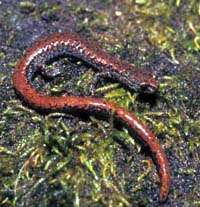Oregon slender salamander
| Oregon slender salamander | |
|---|---|
 | |
| Scientific classification | |
| Kingdom: | Animalia |
| Phylum: | Chordata |
| Class: | Amphibia |
| Order: | Urodela |
| Family: | Plethodontidae |
| Subfamily: | Bolitoglossinae |
| Genus: | Batrachoseps |
| Species: | B. wrighti |
| Binomial name | |
| Batrachoseps wrighti (Bishop, 1937) | |
| Synonyms | |
|
Plethopsis wrighti Bishop, 1937 | |
The Oregon slender salamander (Batrachoseps wrighti) is a species of salamander in the family Plethodontidae from the Northwestern United States.[2][3]
Distribution
The Oregon slender salamander is endemic to north-central Oregon, found particularly on the western slopes of the Cascade Range but also in some sites on the eastern slopes.[1][3][4]
Conservation
The Oregon slender salamander is threatened by habitat loss and classified an IUCN Red List Vulnerable species.[1] It is federally listed as a Species of Concern. The state of Oregon has listed it as sensitive in the Oregon Conservation Strategy.[5]
Habitat
The species' natural habitats are temperate forests of moist Douglas fir, maple, and red cedar woodlands in Oregon, to 910 metres (3,000 ft).[1] They are typically found in old growth habitat, associated with late-successional Douglas fir forests. However they have been found in earlier succession forest with larger logs and lots of downed woody debris. They are found in large diameter decayed logs. They prefer habitats that have a closed canopy.[6] The species has also been found in a suburban landscape.[7]
Description
They have a long thin body and grow to 61 mm (2.4 in) in snout–vent length and 120 mm (4.7 in) in total length, though most individuals are smaller. They have four toes on the hind feet.[3]
Clutch size is 3–11 and the eggs are 4 mm in diameter.[3]
Behaviour
When found this species will coil its body up and remain motionless.[3]
References
| Wikimedia Commons has media related to Batrachoseps wrightorum. |
- 1 2 3 4 Geoffrey Hammerson; Bruce Bury (2004). "Batrachoseps wrighti". IUCN Red List of Threatened Species. Version 2014.3. International Union for Conservation of Nature. Retrieved 10 April 2015.
- ↑ Frost, Darrel R. (2015). "Batrachoseps wrighti (Bishop, 1937)". Amphibian Species of the World: an Online Reference. Version 6.0. American Museum of Natural History. Retrieved 10 April 2015.
- 1 2 3 4 5 "Batrachoseps wrighti". AmphibiaWeb: Information on amphibian biology and conservation. [web application]. Berkeley, California: AmphibiaWeb. 2015. Retrieved 10 April 2015.
- ↑ Bury, RB; Corn, PS (1988). "Douglas-fir forests in the Oregon and Washington Cascades: abundance of terrestrial herpetofauna related to stand age and moisture". Management of Amphibians, Reptiles and Small Mammals in North America. US Forest Service, General Technical Report RM-GTR-166: 11–22.
- ↑ Oregon Department of Fish and Wildlife (2006). "Oregon Conservation Strategy". Oregon Department of Fish and Wildlife.
- ↑ Carey, AB (1989). "Wildlife associated with old growth forest in the PNW". Natural Areas Journal. 9: 151–162.
- ↑ Guderyahn, Laura; Curtis Musson; Ashley Smithers; Benyamin Wishnek & Charlotte Corkran (2010). "Observations of Oregon slender salamanders (Batrachoseps wrighti) in suburban landscapes". Northwest Naturalist. 91 (3): 325–328. doi:10.1898/NWN09-41.1.
